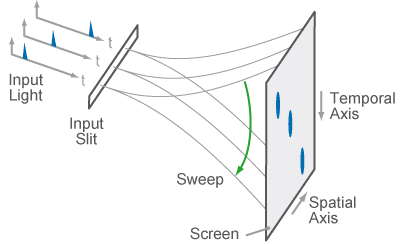The Streak Principle
The streak principle is characterized by imaging an input slit on a screen while the image is swept in orthogonal direction with respect to the slit direction. The sweep is done with constant and well know speed. A temporal information can be related to the screen along the sweep direction and a spatial information can be related along the slit direction. Each point on the screen is therefore related to a time and spatial information. In case sweep speed is high compared to the duration of an optical pulse directed onto the input slit, the pulse is stretched in temporal direction. The length of the pulse on the screen can be related directly to its duration. The streak principle generates images with temporal information along one axis. The axis orthogonal to the temporal axis can stil be used to capture multiple signals as they are available for example on the output of a spectrometer.

The streak principle can be realized by using a rotating mirror. Faster sweep speeds and therefore higher temporal resolution are achieved by using electron tubes, so called streak tubes. The input slit is focused onto the streak tube photocathode. Photoelectrons are emitted and accelerated onto the phosphor screen by high voltage. The image of the input slit appears on the screen. On the way from the photocathode to the screen, photoelectrons are passing deflection plates. A fast voltage transient is applied to deflect the electrons. A readout camera is used to capture the light from the phosphor screen. In many systems an additional amplification stage is needed. This might be an MCP inside the streak tube or an external image intensifier.
